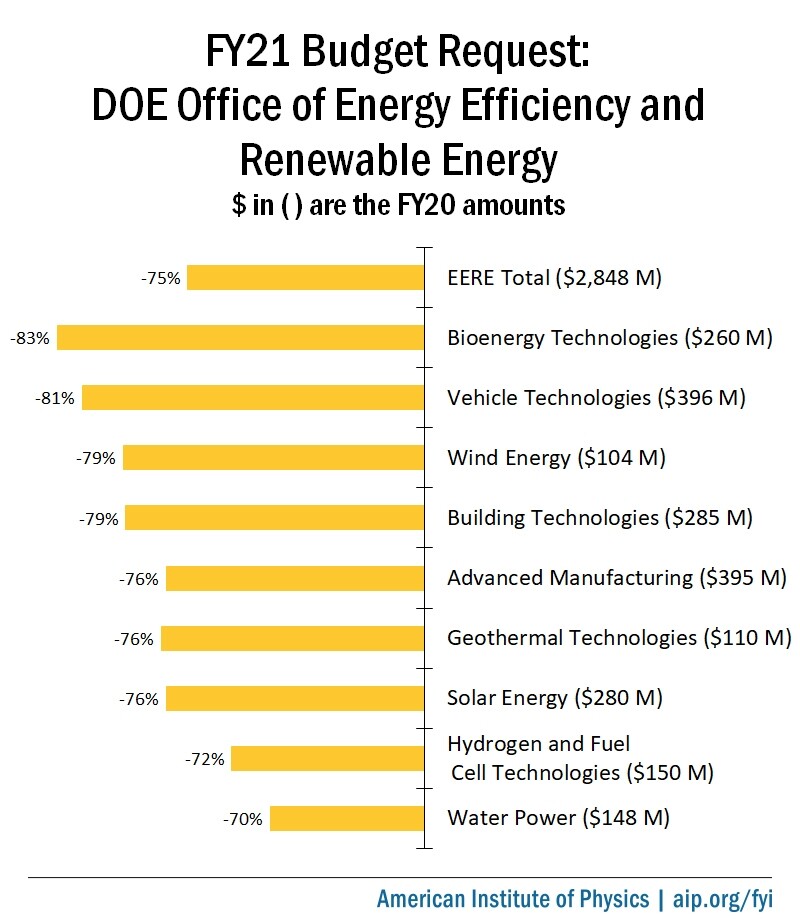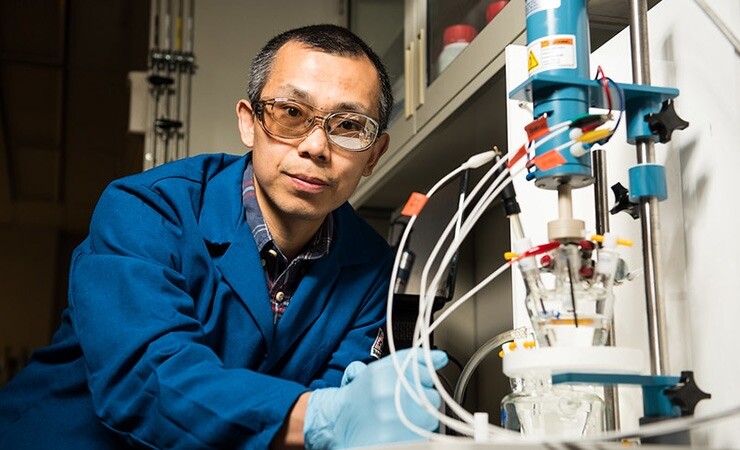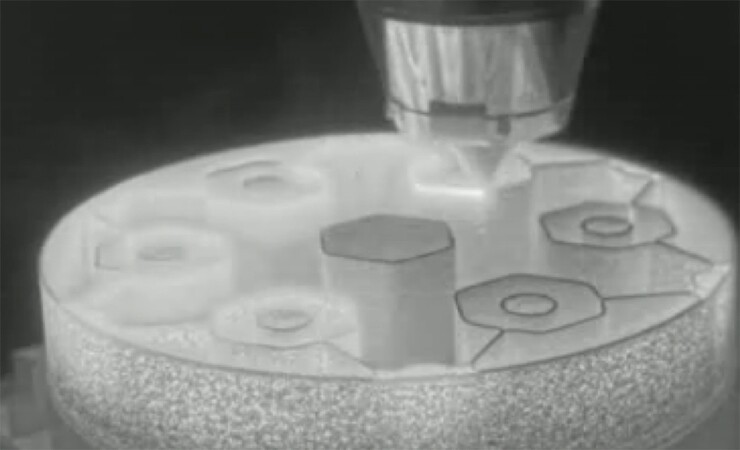
FY21 Budget Request: DOE Applied Energy R&D
In its fiscal year 2021 budget request
As with its request
To date, Congress has generally ignored the administration’s plans for the applied energy R&D programs and instead increased their funding across the board. This year, there are also policy bills pending in the House and Senate that would recommend funding the programs near or above their current levels in the years ahead.
Summary figures from the request and previous appropriations are available in FYI’s Federal Science Budget Tracker


Advanced Research Projects Agency–Energy
Beyond proposing to terminate ARPA–E, the Trump administration is asking Congress to rescind $332 million in unobligated balances from the agency’s current budget. However, Congress has taken a strong interest in ARPA–E since the administration first proposed terminating it in 2017 and is currently funding it at a record-high level of $425 million. Moreover, bipartisan bills currently pending
Energy storage
DOE’s Energy Storage Grand Challenge builds on prior departmental efforts such as the Beyond Batteries initiative and its successor, the Advanced Energy Storage Initiative. It aims to bolster U.S. global leadership in energy storage through R&D funding, prizes, and partnerships, among other mechanisms, and to take a “holistic” approach toward relevant programs scattered across the department. It has also set the specific goal of making the U.S. energy storage industry independent of foreign sources of critical materials by 2030.
The request proposes $214 million for all grand challenge activities across the department, which is substantially less than their current combined level of $367 million. The Office of Energy Efficiency and Renewable Energy (EERE) would see its contribution drop from $283 million to $97 million.
Grid-scale storage. The request proposes to reduce funding for grid-scale energy storage research within the Office of Electricity from $55 million to about $44 million. However, it also proposes $40 million for the construction of a new Grid Storage Launchpad facility at Pacific Northwest National Lab that would modernize and expand research capabilities for the development, testing, and independent validation of battery materials and systems. DOE anticipates the facility will be completed by 2026 and cost between $57 million and $77 million in total.
EERE contributions. EERE’s Vehicle Technologies program would contribute $35 million for grand challenge work focused on improving the cost, range, and charge time of electric vehicle batteries. However, the program’s Battery and Electrification Technologies subprogram would see its budget slashed from $175 million to $49 million under the request. The remainder of EERE’s contribution would be drawn from six other programs with similarly reduced toplines.
Other offices. The request also proposes small grand challenge contributions from the Offices of Nuclear Energy and Fossil Energy. The Office of Science plans to continue funding the Joint Center for Energy Storage Research, an Energy Innovation Hub based at Argonne National Lab, at about $24 million.
Congressional interest. Congress has recently advanced several policy bills focused on energy storage. The Senate’s bipartisan American Energy Innovation Act
Critical minerals
DOE states it is establishing a new department-wide initiative focused on meeting “aggressive, yet achievable goals … to diversify supply of, develop substitutes for, and drive recycling, reuse, and more efficient use of critical minerals.” It is requesting $131 million in total for activities related to the initiative, a decrease from the $147 million allocated to them within DOE’s current budget.
Critical minerals such as rare earth elements are important for fabricating many technologies, including energy technologies, but they can be difficult to mine and are generally obtained from sources outside the U.S. The new initiative responds to an executive order
Critical Materials Institute. The request states that DOE plans to dissolve its Critical Materials Institute, an Energy Innovation Hub located at Ames Laboratory in Iowa, and replace it with a broader national laboratory-led consortium modeled on the existing Grid Modernization Laboratory Consortium

Yuyan Shao, a researcher at Pacific Northwest National Lab, tests a fuel cell catalyst material that does not employ platinum-group metals.
(Image credit – Andrea Starr / PNNL)
EERE contributions. The request proposes that EERE contribute almost $53 million to the initiative, of which about $31 million would be from its Advanced Manufacturing program. The Vehicle Technologies program would contribute another $15 million focused on R&D related to cobalt use and recycling and reducing the use of heavy rare earths in electric vehicle drive systems. The Geothermal Technologies program would contribute $4 million focused on the separation of critical minerals from geothermal brines, and $3 million from the Hydrogen and Fuel Cell Technologies program would go toward reducing the use of platinum-group metals in fuel cell catalysts.
Other programs. Within the Office of Fossil Energy, the request proposes increasing funding from $23 million to $32 million for its R&D program on the separation of rare earth elements from coal and coal byproducts. The Office of Science would contribute $45 million, including $25 million through the Basic Energy Sciences program for research related to the separation, recycling, and substitution of rare earths.
Renewable energy
Water Power. Within its 70% cut to the Water Power program’s topline, the administration is seeking a 36% cut for its Hydropower Technologies program and an 82% cut for its Marine and Hydrokinetic Technologies program. The discrepancy reflects a relative prioritization of work on hydropower grid integration and pumped storage. However, Congress has recently prioritized the Marine and Hydrokinetic program, increasing its funding from $41 million to $109 million over the last five years, while increasing the Hydropower Technologies budget from $19 million to $39 million. Policy bills in the House
Geothermal Technologies. While Congress has doubled funding for the Geothermal Technologies program over the last five years, from $55 million to $110 million, the administration proposes to cut its budget down to $26 million. Policy bills pending
Solar and Wind Energy. While the administration is proposing to cut more than three-quarters from the Solar Energy and Wind Energy program budgets, pending policy
Nuclear energy
Versatile Test Reactor. Although the administration proposes cuts to most elements of DOE’s nuclear energy program, it is seeking to ramp up funding for construction of the Versatile Test Reactor facility from $65 million to $295 million. The facility would provide a U.S.-based capability for irradiating fuels, components, and materials intended for use in certain advanced reactor designs with the high-energy neutrons the reactors would employ. DOE provisionally estimates the facility will cost between $3 billion and $6 billion to build. There is bipartisan support for the facility in the House, where pending legislation
Transformational Challenge Reactor. The administration proposes to increase funding from $23 million to $30 million for a project

A nuclear reactor component being fabricated using additive manufacturing methods at Oak Ridge National Lab.
(Image credit – ORNL)
Advanced reactor demonstrations. In its appropriation for this year, Congress provided DOE with $230 million to establish a new advanced reactor demonstration program, including $160 million for the first year of two demonstration projects. The administration proposes to limit the awards to one year of support and therefore requests only $20 million for certain residual activities.
Nuclear waste storage. Reversing its position, the administration requests no funds this year to restart work on the long-stalled Yucca Mountain nuclear waste repository in Nevada. The state is deeply opposed to the project and President Trump spotlighted his new stance in a tweet
Fossil energy and carbon reduction
Coal FIRST initiative. Within the administration’s proposed cut to the Office of Fossil Energy’s topline, it proposes to increase funding for the Power Generation Efficiency program from $34 million to $217 million. The additional funding would advance Coal FIRST, the office’s “flagship” initiative to support “R&D insights and integrated designs of the coal plant of the future.” According to DOE, such plants would operate with higher efficiency, employ smaller and lower-cost power-generation units, and produce zero or near-zero emissions. Although the administration also proposed a sizable boost for the initiative last year, Congress ultimately reduced the program’s budget.
Carbon capture, sequestration, and utilization. The administration proposes to reduce combined funding for carbon capture, sequestration, and utilization programs from $218 million to $123 million. However, Congress has recently increased funding for these programs and in its latest appropriation provided dedicated funding for R&D on methods for removing carbon dioxide directly from the atmosphere.
Grid integrity
Grid resilience. Within the Office of Electricity, the administration is requesting funding for continued work on the North American Energy Resilience Model, which aims to improve DOE’s planning and contingency analyses related to electric grid vulnerabilities. It also includes funding to contribute to a potential new university-based National Science Foundation Engineering Research Center dedicated to obtaining “fundamental knowledge” about aspects of the electric power system.
Electromagnetic hazards. Within the Office of Cybersecurity, Energy Security, and Emergency Response, the administration requests $30 million to establish a “national physical energy system and component testing capability” for studying threats to the energy system from geomagnetic disturbances and electromagnetic pulse attacks. Congress rejected an identical request in its last appropriation, suggesting DOE had not shown why existing facilities could not be used for such work.


